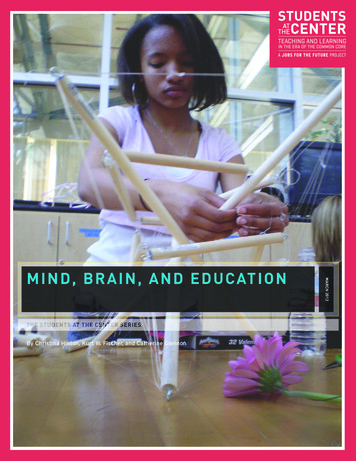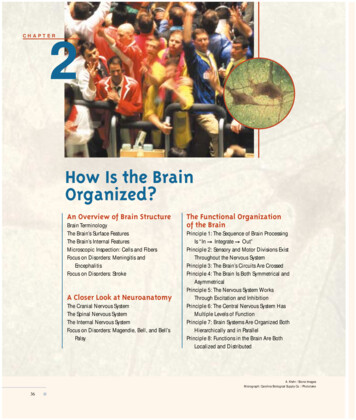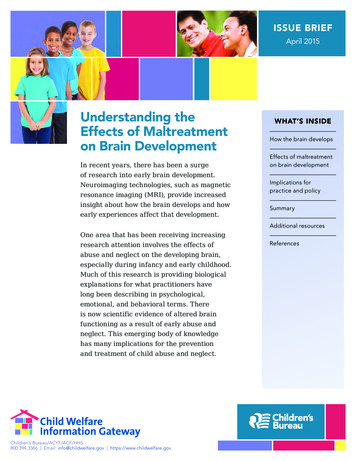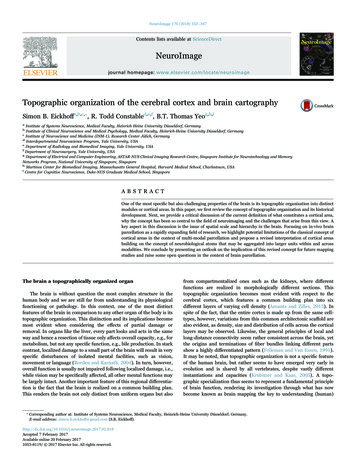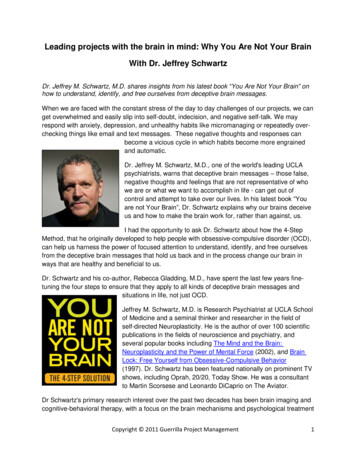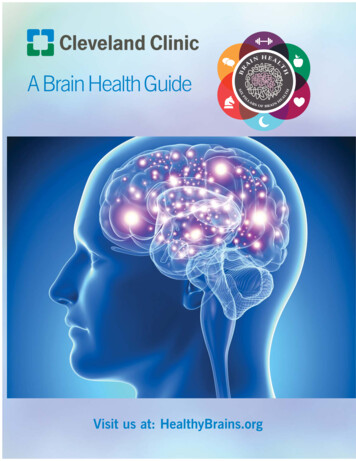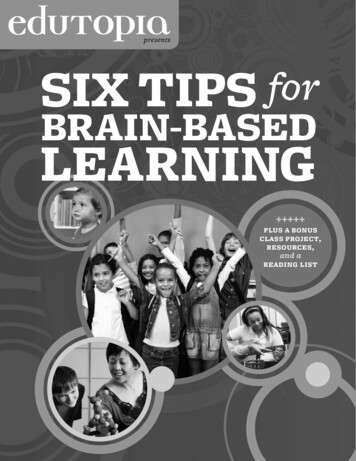
Transcription
presentsSIX TIPS forBRAIN-BASEDLEARNING PLUS A BONUSCLASS PROJECT,RESOURCES,and aREADING LIST
Six Tips forBrain-Based LearningPlus, a bonus class project, resources, and a reading listBY UNDERSTANDING HOW THE BRAIN WORKS, educators arebetter equipped to help students with everything from focusing attentionto increasing retention. That’s the promise of brain-based learning,which draws insights from neurology, psychology, technology, and otherfields. Bringing this information to the classroom can help teachersengage diverse learners, offer effective feedback that leads to deeperunderstanding, and create a rich learning environment that attends tostudents’ social and emotional needs along with their developing brains.Chances are, you already know more about brain-based learning thanyou think you do. When you introduce topics to your students, do youbegin by activating prior knowledge? That helps learners build on what theyalready know, strengthening connections in the brain. Do you use toolslike graphic organizers, songs, or rhymes? These strategies help studentsrepresent their thinking visually, kinesthetically, and phonetically. Thesetechniques all deserve a place in your tool kit because they get the brainprimed for learning.Patricia Kuhl, renown language and brain development researcher, putsit this way, “We are embarking on a grand and golden age of knowledgeabout the child’s brain development. . . . In investigating the child’s brain,we are going to uncover deep truths about what it means to be human,and in the process, we may be able to help keep our own minds open tolearning for our entire lives.”In this guide, you’ll get practical tips across the K-12 spectrum, a readinglist, and a variety of resources to help you learn more about thisfascinating field. To help you and your students learn more about their ownbrainpower, we’ve also included a bonus project that will get studentsthinking critically about thinking.As promising as brain-based discoveries may sound, some educators areunderstandably cautious about introducing lab findings in the classroom.Anyone who remembers fallout over the so-called Mozart effect knowsthat there’s no magic solution when it comes to education. As always, ifa particular claim sounds too good to be true, that’s a clue to trust yourcommon sense and engage your own critical thinking.We’re eager to hear how you apply brain-based learning with yourstudents. Please share your insights and help build the bridge fromneuroscience research to engaging classroom practice.—Suzie BossEdutopia blogger and co-author ofReinventing Project-Based LearningOn Twitter @suziebossvisit edutopia.orgTIPS ATA GLANCE1.2.3.Create a SafeClimate for LearningEncourage aGrowth Mind-setEmphasizeFeedback4. Get Bodies andBrains in Gear5.Start Early6. Embrace thePower of NoveltyBONUSPROJECTBuild a BrainOwner’s Manual RecommendedReading
tip #1Create a Safe Climatefor LearningWHEN STUDENTS ARE FEELING ANXIOUS or fearful, they aren’tin the mood to learn. That’s because one part of the brain that processesemotions—the amygdala—responds to perceived threats by blockinginformation flow to the learning centers of the brain. In layman’s terms,stress scrambles the learning circuits. To understand more about how thebrain responds to stress, read the Edutopia article “To Enable Learning,Put (Emotional) Safety First” earning-emotional-safety).Although educators can’t overcome every stressor in a child’s life, they cantake practical steps to make the classroom environment more conduciveto learning. Veteran teacher Linda Lantieri, author of Building EmotionalIntelligence, recommends concrete strategies to help students stay calm andlearn to manage their sometimes tumultuous emotions. As she explains inan Edutopia interview, “The prefrontal cortex of the brain is the area forpaying attention, calming, and focusing as well as the area for short- andlong-term memory. So you need to focus in order to connect with yourmemory.” Read more of her interview at ation.Morning meetings, developmental discipline, and student leadershipteams are among the strategies that can foster healthy social and emotionallearning. Learn how a school district in Louisville, Kentucky, has implementedstrategies to build students’ emotional health in this Schools That Worksegment: http://www.edutopia.org/stw-jefferson.Learning environments that keep students highly engaged, that fostercommunity and family connections, and that consider the needs of thewhole child are the focus of a recent podcast by The Whole Child fromASCD. For more ideas, listen to “School Environments: TransformingLearning Spaces” .3SIX TIPS FOR BRAIN-BASED LEARNINGLearn more: Watch a University of Minnesota video seminar on the impactsof stress on learning: s/StressandLearning/index.html.Watch a lecture by ProfessorClaude M. Steele on Identityand Stereotype Threat:http://www.youtube.com/watch?v q1fzIuuXlkk.Watch the Edutopia video “AnIntroduction to Social andEmotional Learning”: ntroduction-video.Watch the previously recordedwebinar “Social and EmotionalLearning: Making a Case in anNCLB World”: http://www.edutopia.org/webinar-february.Eric Jensen, author of Teachingwith Poverty in Mind, sharesteaching tips in the post “WhyTeach Differently to Thosefrom Poverty?” n-mind#postcomment.EDUTOPIA.ORG
tip #2Encourage aGrowth Mind-setASK STUDENTS TO DESCRIBE their brain with a metaphor andthey’re likely to suggest a computer, command center, or maybe a lightningfast communications network. But they’d be better off thinking of the brainas a muscle that gets stronger with use. Researchers now understand thatIQ isn’t fixed at birth. Just as we get more physically fit from exercising, wecan build brainpower through the act of learning.Children who adopt what psychologist Carol Dweck calls a growth mind-setunderstand that intelligence isn’t fixed but can be developed through effort.In Mindset, Dweck explains why students who have a growth mind-set aremore willing to tackle challenges, learn from failure, and see criticism asuseful feedback rather than a reason to give up. This is the kind of thinkingthat keeps students motivated, even when learning is hard work. To learnhow Dweck’s research can improve the classroom environment, read MiltonChen’s Edutopia post “Smart Talking: Tell Students to Feed Their lligence-research).The good news is that even mind-set isn’t fixed. A growth mind-set canbe learned and reinforced by messages that praise persistence and set highexpectations. For example, help students understand that challengingassignments will stretch their “thinking muscles.” At the same time,provide them with necessary support so they don’t get discouraged.(Edutopia blogger Rebecca Alber offers suggestions in “Six ScaffoldingStrategies to Use with Your Students”: ix-strategies-rebecca-alber.)Curious to learn more? In Mind, Brain, and Education Science, a comprehensiveguide based on more than 4,500 studies, Tracey Tokuhama-Espinosa presentsfive key concepts on the topic. These concepts give us an accessible frameworkfor talking about, and learning about, brain-based learning: Learn more: Watch Dr. Norman Doidge's talkon brain plasticity: http://youtu.be/dJxASN- WtU. Listen to an interview on thegrowth mind-set with CarolDweck: Id 7406521. And listento Dweck explain her researchin a series of video ery.aspx. Diane Dahl is an elementaryteacher who regularly appliesbrain-based learning strategies.Visit her blog to hear how sheincorporates “thinking aboutthinking” into daily learningactivities, such as this lesson about having studentsmodel neural pathways: gnitionlesson-was-huge-success.html.Human brains are as unique as faces.All brains are not equal because context and ability influence learning.The brain is changed by experience.The brain is highly plastic.The brain connects new information to old.Read an excerpt from Tokuhama-Espinosa’s book in New Horizonsfor Learning, a new journal from Johns Hopkins University School ofEducation ter2011/Tokuhama1).Effective teaching strategies help students move toward higher-orderthinking, or what neurologists call executive function. As neurologist turnedteacher Judy Willis, MD explains, “When you (continued on next page)4SIX TIPS FOR BRAIN-BASED LEARNINGEDUTOPIA.ORG
tip #2provide students with opportunities to apply learning, especially throughauthentic, personally meaningful activities with formative assessmentsand corrective feedback throughout a unit, facts move from rote memoryto become consolidated into related memory bank, instead of being prunedaway from disuse.” Follow Willis’s Edutopia posts to learn why, as she says,“the neurons that fire together wire together” s).Of course, all this brain activity is happening in a unique way for eachstudent. By addressing learners’ individual needs, educators can helpstudents strengthen the connections that will lead to deeper understanding.Experts David A. Sousa and Carol Ann Tomlinson team up to explain thescience behind differentiated instruction in Differentiation and theBrain: How Neuroscience Supports the Learner-Friendly Classroom. Theysuggest having faculty discussions about how teachers’ and administrators’attitudes and behaviors (as well as school environments and procedures) canencourage—or discourage—a growth mind-set. Download their discussionReproducibles: lesDAB.html. And for ideas about delivering differentiated instruction on aslim budget, see Edutopia’s Schools That Work installment about a highachieving elementary school in Tucson, Arizona: tion-budget-overview.5SIX TIPS FOR BRAIN-BASED LEARNINGEDUTOPIA.ORG
tip #3Emphasize FeedbackEDUCATIONAL RESEARCHERS HAVE long stressed the value offeedback for keeping learning on track. Savvy classroom teachers use arange of formative assessment strategies to check in on understanding andaddress misconceptions early. Not surprisingly, feedback is a cornerstoneof brain-based learning.In Mind, Brain, and Education Science, Tokuhama-Espinosa points out,“Great teachers know that moments of evaluation can and should alwaysbecome moments of teaching.” That means students need to know morethan whether their answers were right or wrong. Understanding whereand how they went wrong helps students adjust their thinking so they canimprove. Positive feedback, meanwhile, builds learner confidence. Whetherit’s corrective or affirming, feedback needs to be delivered in a way that’sencouraging rather than discouraging.And implementing an effective on-the-fly feedback process is what’s drivingmuch of the excitement around using video games in classrooms. Neurologistturned middle school teacher Judy Willis, MD explains how the dopaminereward system works, why feedback matters, and what educators can learnfrom the achievable challenges of games in her Edutopia post “A NeurologistMakes the Case for the Video Game Model as a Learning Tool” -student-engagementjudy-willis).Longtime advocate of brain-based learning Eric Jensen says a wide range ofactivities—particularly peer editing—can deliver the personal and relevantfeedback students’ brains need to thrive. In a recent blog post, he suggests,“Use gallery walks, have students build a physical model, provide games withcompetition, implement using an author’s chair, small-group discussion,use audio or video feedback, peer editing, student presentations, hypothesisbuilding and testing, have students use a checklist, engage them in brainstorming, compare and contrast work” ties-right/brain-based-teaching).A variety of Web 2.0 tools can be used to deliver timely, specific feedback thatwill help students make academic gains. Web2ThatWorks Wiki (http://web2thatworks.com) is a collaborative space developed by instructional coachStephanie Sandifer (@ssandifer on Twitter) where educators are sharingideas about technologies that support effective instruction.6SIX TIPS FOR BRAIN-BASED LEARNINGLearn more: Read Edutopia blogger HeatherWolpert-Gawron’s practical post“Tips for Grading and GivingStudents Feedback”: eedback-heather-wolpertgawron. To help you maximize feedbackopportunities during projects,download a copy of the EdutopiaClassroom Guide Top Ten Tipsfor Assessing Project-BasedLearning: based-learningresource-guide. See a demonstration of peerfeedback in the classroom inEdutopia’s video on how toteach math as a social ooperativelearning-videoEDUTOPIA.ORG
tip #4Get Bodies andBrains in GearDEVELOPMENTAL MOLECULAR BIOLOGIST John Medina, authorof Brain Rules, describes himself as a “grumpy scientist” who demands agold standard from research before he’ll pass it along. His No. 1 researchbased rule for brain owners to keep in mind? Exercise boosts brainpower.Cardio activity increases oxygen-rich blood flow to the brain and increasesstudents’ ability to concentrate. Acknowledging that more study is neededto fully understand the relationship between exercise and learning, Medinaargues for incorporating more physical activity into the school day—now.For an action-packed example, see how students at Naperville Central HighSchool in Illinois combine fitness with academics. Ninth and tenth graders in alearning readiness program take fitness-based PE before their most challengingacademic courses (http://www.learningreadinesspe.com). PE teacherscollaborate with academic colleagues to find more opportunities for “brainbreaks” that get students moving during class. Watch a PBS “Need to Know”episode about the program ical-education-in-naperville-ill/7134/).For a global look at how young learners are benefiting from physical activity,check out the Learning Landscape Network (http://www.learninglandscapenetwork.com/). This open-source community, developed bythe nonprofit design firm Project H Design, is collecting creative ideas forusing low-cost play spaces built from discarded tires to develop core subjectskills. Originally intended for math instruction, the Learning Landscapeconcept has expanded to include physically active learning games acrossthe curriculum.7SIX TIPS FOR BRAIN-BASED LEARNINGLearn more: Read the American Physiological Society’s description of thebenefits of exercise on brain .htm.John J. Ratey, MD, author of Spark:The Revolutionary New Scienceof Exercise and the Brain, sharesvideos and articles about exerciseand learning on his blog: http://johnratey.typepad.com/blog/.Take multimedia tutorials orlisten to an interview with JohnMedina at the website http://www.brainrules.net.Visit KaBOOM! for research onrecess, play, and healthy childdevelopment. Go to http://www.kaboom.org, then click on thetab “Take Action for Play” andscroll to “Why Play Matters.” Watch a TED talk with Project Hfounder Emily Pilloton: http://www.ted.com/talks/emilypilloton teaching design forchange.html.EDUTOPIA.ORG
tip #5Start EarlyFORMAL SCHOOLING MAY NOT START until age five, but we allknow children are learning long before they begin kindergarten. By reachingout to parents of preschoolers with research and practical information,schools can help incoming students arrive at school ready—and eager—to learn.At Education Nation 2011, an annual summit on education hosted by NBCNews, researchers from the University of Washington shared never-seenbefore research about what happens in the brain and its 100 billion neuronsduring the first 2,000 days of life. Patricia Kuhl and Andrew Meltzoff explainedthe importance of a series of images showing how children’s brains change asthey listen to language, interact with other people, and develop connections.Watch the video presentation at Education Nation (go to http://www.educationnation.com and search for Patricia Kuhl).Many states have launched early childhood campaigns to help childrenarrive at kindergarten ready to learn. Less than half the children in Washington,for example, enter school kindergarten-ready, according to University ofWashington data, and only a quarter of the lowest-income students startschool ready to learn. To improve these odds, Washington has launched agrassroots campaign around the themes “Love. Talk. Play.” See suggestionsfor activities that parents can do with their young children at http://www.lovetalkplay.org.What’s really happening when babies play? Psychology professor AlisonGopnik, author of The Philosophical Baby, answers that question with somesurprising answers in her TED talk “What do babies think?”: http://www.ted.com/talks/alison gopnik what do babies think.html.8SIX TIPS FOR BRAIN-BASED LEARNINGLearn more: Read about the impacts ofpreschool education from a25-year longitudinal /110609141556.htm. Watch a video about theimportance of early learning,featuring the Center onthe Developing Child atHarvard University: http://youtu.be/7Qb3DXY 7fU. Read the New York Times opinionpiece “Delay Kindergarten atYour Child’s Peril” written bySam Wang and Sandra Aamodt,authors of Welcome to YourChild’s Brain: How the MindGrows From Conception toCollege: RG
tip #6Embrace thePower of NoveltyWHEN WE ENCOUNTER NEW information, the brain quickly goes intopattern-recognition mode. If it reminds us of something we’ve encounteredbefore, we know how to respond. But what happens when the new informationdoesn’t “fit” with existing understanding? That’s when the brain really getsexcited. The brain doesn’t just detect new information—it craves novelty.As Judy Willis, MD explains in How Your Child Learns Best, a part of thebrain called the reticular activating system (RAS) filters incoming stimuli,deciding which information to trust to autopilot and what deserves our fullattention. Surprise and novelty are the attention-grabbers. In the classroom,this means that changing routines, asking students to consider similaritiesand differences, field trips, and guest visitors all help to keep learning fresh.In an article for Scholastic, psychiatrist and child trauma expert BrucePerry explains why repetitive classroom activities, such as lectures orworksheets, inhibit the brain’s craving for novelty and can interfere withlearning. “Only four to eight minutes of pure factual lecture can be toleratedbefore the brain seeks other stimuli, either internal (e.g., daydreaming) orexternal (Who is that walking down the hall?). If the teacher is not providingthat novelty, the brain will go elsewhere,” he writes in “How the Brain LearnsBest.” (For more of his advice for teachers, visit rry/.)Integrating a robust arts program is one way educators can capturestudent curiosity and keep them engaged. According to a recent landmarkreport from the President’s Committee on the Arts and the Humanities, thebenefits of studying the arts go far beyond enrichment. Reinvesting in ArtsEducation—Winning America’s Future Through Creative Schools found that ahigh-quality program can improve student engagement, focus attention,heighten educational aspirations, and increase intellectual risk taking.Download a copy from http://www.pcah.gov/.And planning inquiry-driven projects that connect to students’ interestswill boost the engagement factor and cut down on boredom, which is actuallya stressor for young brains. Willis explains why in the video interview “BigThinkers: Judy Willis on the Science of Learning” neuroscience-learning-video).9SIX TIPS FOR BRAIN-BASED LEARNINGLearn more: Skype in the Classroomoffers educators a way to addnovelty at no cost throughvideoconferencing. Join thisglobal educator community andconnect your students with newfaces from around the world:http://education.skype.com/. Field trips add novelty, but ata cost that many schools can’tafford. Read this Edutopia articleabout virtual field trips to findout how to expand your students’world on a budget: http://www.edutopia.org/virtual-field-trips. Inquiry-based curriculum canalso bring new energy to class.Check out the sample assignmentsfrom Quest to Learn, an innovativeNew York school that addressesserious academic goals througha challenging standards-basedcurriculum via game building,scientific experiments, and amyriad of other activities: http://q2l.org/node/27#curriculum.EDUTOPIA.ORG
BONUS PROJECT: Build a Brain Owner’s ManualBRAIN-BASED EDUCATION reinforces the importance of learning activitiesthat are relevant, novel, multisensory, and challenging enough to stretchstudents’ “thinking muscles.” If you’re a student, what could be morepersonally relevant than learning about your own brain? By combiningproject-based learning with neuroscience, you can offer students anopportunity to follow their curiosity and engage their creativity whenit comes to understanding the brain. Here’s how to get started.Step1BuildYOUR UNDERSTANDINGBefore diving into project design, you may want tobuild your own background knowledge about howto integrate brain study across the curriculum.Increasing brain-science literacy is somethingthat will benefit students of all ages, according toMichaela Labriole, science instructor at New YorkHall of Science. In Cerebrum, she makes a strongcase for why K-12 teachers should integrate brainrelated topics in the classroom. Online resourcesand classroom activity suggestions help get youstarted (http://www.dana.org/news/cerebrum/detail.aspx?id 28896).Neurologist and former teacher Judy Willisdescribes how her elementary and middle schoolstudents benefited from studying the brain in anarticle for Educational Leadership. She explains,“When I began incorporating basic instructionabout the brain into my classes and teaching simpleactivities to improve brain processing, studentsnot only became more engaged and confident, butthey also began changing their study practices inways that paid off in higher achievement.” Read herarticle “How to Teach Students About the nts-About-the-Brain.aspx).Step2CraftA COMPELLINGDRIVING QUESTIONPlan your project with a driving questionthat will set the stage for deep learning.Crafting the right question for yourproject will depend on grade level,subject area, and important learninggoals. It should be open-endedenough so that students can’t easilyGoogle an answer and sufficientlyintriguing to grab their attention.(Remember: The brain craves novelty.)For example: How can we develop abrain owner’s manual?Depending on students’ ages andinterests, this open-ended questioncould lead them to investigate sleephabits for healthy brains, how athletescan avoid head injuries, strategies toimprove long-term memory, how toinspire more creative thinking, howto be smart about taking risks, and awide range of other topics.(continued on next page)10 SIX TIPS FOR BRAIN-BASED LEARNINGEDUTOPIA.ORG
Step3PlanENGAGING ACTIVITIESDuring the research phase of the project, plan activitiesthat will help students investigate what they need to know.A wide range of resources are available. Here are a few: BrainWorks, a video from the University of Washington,takes students on a journey through the brain. Kids alsovisit research labs to learn about brain function andbrain research (http://www.uwtv.org/video/player.aspx?dwrid 4909). Brainology (http://www.brainology.us/) is an onlineprogram designed to help students develop a growthmind-set. It was developed by psychologist Carol Dweckand researcher Lisa Sorich Blackwell. Teens can take a risk-tolerance quiz from a recentNational Geographic article about teenage eenagebrains/risk-quiz). (The full article,“Beautiful Brains,” is available at brains/dobbs-text.) Brainy Kids (http://www.dana.org/resources/brainykids/) is a youth education site about the brain from theDana Foundation. It includes games, online labs, andlinks to lessons and activities. Make a brain cap: University of Texas Health ScienceCenter at San Antonio outlines an activity that engagesstudents in modeling their understanding of the brain’sanatomy in/brain01b-BrainCap.asp). Contribute to science: Students can participate inresearch by taking part in online experiments at TestMy Brain (http://www.testmybrain.org/). After theytake part in experiments such as identifying emotionsfrom tone of voice or testing their “gut number sense,”students get personalized feedback.As a professional development activity, consider exploringthe growing literature about brain-based learning withcolleagues. You might do jigsaw readings of key research orchoose a brain-based title for an all-staff book club. The DanaFoundation maintains links to research in neuroeducation(http://dana.org/neuroeducation/). See our suggestedreading list at the end of this guide for more ideas.11 SIX TIPS FOR BRAIN-BASED LEARNINGStep4ShareYOUR RESULTS Let others know aboutyour project by describingyour results in the EdutopiaPBL community: http://www.edutopia.org/groups/project-learning. Visit Edutopia’s resourceroundup of brain-basedlearning links and shareyour favorite websitesand tools rchroundup). Join The Educator’s PLN,a personal learningnetwork for educators,and take part in activediscussions in the BrainBased Teaching chniques.EDUTOPIA.ORG
RECOMMENDEDREADING How People Learn: Brain, mind, experience,and school: Expanded Edition.Mind, Brain, and Education:Neuroscience implications for the classroom.Mindset: The new psychology of success.Differentiation and the Brain:How neuroscience supports thelearner-friendly classroom.By J.D. Bransford, A.L. Brown & R.R. Cocking (2000)Washington, DC: National Academy Press.By C. Dweck, (2006)New York, NY: Ballantine Books.The Philosophical Baby: What children’s mindstell us about truth, love, and the meaning of life.By A. Gopnik (2010)New York, NY: Picador.Teaching with Poverty in Mind:What being poor does to kids’ brainsand what schools can do about it.By E. Jensen (2009)Alexandria, VA: ASCD.Brain Rules: 12 principles for survivingand thriving at work, home, and school.By D. Sousa (Ed.) (2010)Bloomington, IN: Solution Tree Press.By D. Sousa & C. Tomlinson (2010)Bloomington, IN: Solution Tree Press.Mind, Brain, and Education Science:A comprehensive guide to the newbrain-based teaching.By T. Tokuhama-Espinoza (2011)New York, NY: W.W. Norton & Co.How Your Child Learns Best: Brain-friendlystrategies you can use to ignite your child'slearning and increase school success.By J. Willis (2008)Naperville, IL: Sourcebooks.By J. MedinaSeattle, WA: Pear Press.12 SIX TIPS FOR BRAIN-BASED LEARNINGEDUTOPIA.ORG
Six Tips forBrain-Based LearningPlus, a bonus class project, resources, and a reading list ABOUT EDUTOPIAEdutopia is where The George Lucas Educational Foundation’svision to highlight what works in education comes to life. Weare a nonprofit operating foundation dedicated to improvingK-12 learning by documenting, disseminating, and advocatingfor innovative strategies that prepare students to thrive in theirfuture education, careers, and adult lives.Through our award-winning website, videos, and growingonline community, Edutopia is supporting and empoweringeducation reform by shining a spotlight on real-world solutionsand providing proven strategies, tools, and resources that aresuccessfully changing how our children learn.To find and share solutions, visit Edutopia.org.SUPPORT EDUTOPIA!WHAT WORKS IN EDUCATIONDonate to Edutopia and join with others who careabout changing education. Your support will help uscontinue to do the following: Identify key attributes ofsuccessful learning environments Bridge the gap between those who are strugglingand those who have solutions Improve online tools and resources for educatorsto collaborate and share with one another Highlight districts and schools that have impactfuland replicable solutionsPlease join us in ushering in a new world of learning.To make your tax-deductible donation, go toedutopia.org/support.visit us at edutopia.org13 2011 The George Lucas Educational Foundation All rights reserved. 2011 The George Lucas Educational Foundation All rights reserved.
about the child’s brain development. . . . In investigating the child’s brain, . whole child are the focus of a recent podcast by The Whole Child from ASCD. For more ideas, listen to “School Environments: Transforming . download a copy of the Edutopia




